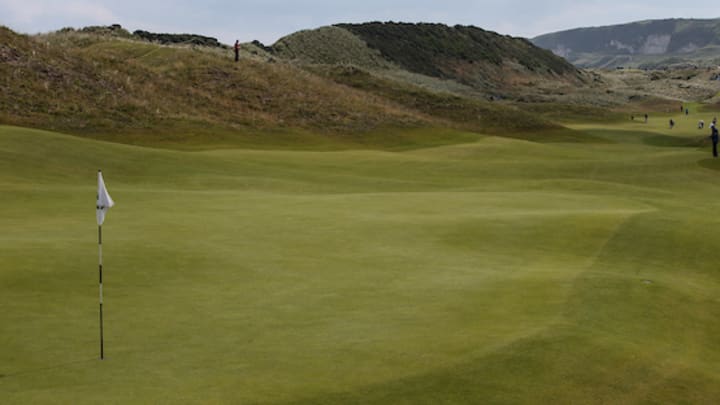It's showtime for Portrush's Dunluce Links

PORTRUSH, Northern Ireland – At last, the sun has gone into hiding, the rains have arrived, the temperature has dropped and the wind has kicked up. The table is set for the 148th British Open.
Now, we will find out whether the Dunluce Links at Royal Portrush is as good as advertised (tee times).

© GOLFFILE/DAVID LLOYD
The view from behind the 7th green at Royal Portrush, site of the 148th British Open, which begins today.
Will Rory McIlroy, the betting favorite, rise to the occasion? Can Brooks Koepka – whose caddie, Ricky Elliott, grew up in Portrush and knows every nook and cranny of the course – erase the sting of near misses at the Masters and U.S. Open that prevented him from arriving here with a Grand Slam in his cross hairs?
Can Tiger Woods, who acknowledged that his Masters victory exacted a heavy emotional and physical toll, summon another miracle? Might Francesco Molinari prove that his debacle at Amen Corner was an anomaly and retain the Claret Jug for another year?
Will Jon Rahm continue his mastery of Irish links? How will Gary Woodland fare after winning the U.S. Open, his first major, last month at Pebble Beach? Or will a little-known journeyman ultimately steal the show at Portrush?
Whoever wins will do it with guile and resiliency. Showers are forecast for all four rounds, although locals put little stock in weather reports. Portrush weather, they say, does what it pleases, when it pleases.
“I don’t think anybody likes playing in cold, rain and wind,” said Rahm, who won the Irish Open two weeks ago in benign conditions at Lahinch. “On days like that, your technique, plans, systems, strategies – you’ve got to throw them out the window and survive the round. Each shot is the most important shot. And you have to trust your feel more than anything else.
“You’ve got to get the ball in the hole any way possible,” he said. “It doesn’t need to look pretty.”
Dunluce is a serpentine 7,344-yard, par-71 layout that winds through colossal dunes. It’s been an ideal summer for growing grass in Northern Ireland, meaning the rough is tall and juicy. A badly missed fairway yields high risk of a lost ball. When an errant drive is found, slashing out sideways to the fairway is generally the only option. Tricky crosswinds can befuddle even the most precise ball-strikers.
There are only 57 bunkers on the Dunluce Links, and those in fairways are exceptionally penal.
“You have to navigate the bunkers and navigate around the golf course,” Woods said. “That’s understanding how to play an Open Championship.”
Wind direction and force dictate whether a player tries to fly certain fairway bunkers or lays up. Hole locations affect strategy, as well. Some pins may be more accessible with longer, higher approach shots rather than bombing a drive and trying to chip or pitch the ball close.
Players have lavished praise on the Dunluce Links all week.
“The golf course is phenomenal,” Woodland said.
The R&A confirmed that 237,750 tickets have been sold, a record for British Opens not played at St. Andrews. Regardless of how soggy it gets, expectations for a festive, Guinness-fueled atmosphere are high.
Unspoken is the fear that some sort of violent incident could ruin the Portrush party. There’s apprehension in some quarters that the “Festival of Bands” scheduled for Saturday evening in Portrush and sponsored by the loyalist Sons of Ulster will be seen as a sectarian provocation.
It’s a fact that enmity and mistrust still linger between Protestants and Catholics, unionists and republicans. One need only to drive through the Bogside neighborhood of Derry, 35 miles southwest of Portrush, with its outdoor murals depicting the “Battle of Bogside” in January 1969, and “Bloody Sunday” in January 1972, for evidence of anti-British sentiment.
McIlroy, who grew up in Belfast, said he was oblivious to “The Troubles” as a child. He thinks that concerns about politics disrupting the British Open are unfounded and outdated.
“People have moved on,” McIlroy said. “It’s a different time.
“It’s amazing to think, 40 years on, [Northern Ireland is] such a great place,” he said. “No one cares who they are, where they’re from, what background they’re from. You can have a great life, and it doesn’t matter what side of the street you come from.”
The fact that a sporting event the magnitude of the British Open can be staged in Northern Ireland, McIlroy said, “speaks volumes of where the country and where the people who live here are now. We’re so far past that. And that’s a wonderful thing.”
Let’s hope he’s right. Portrush deserves to succeed.
Dave Seanor has been a sports journalist since 1975, including a 13-year stint as editor of Golfweek magazine. He has covered golf in 25 countries, including the 2016 Olympics in Brazil. Email: daveseanor@gmail.com
